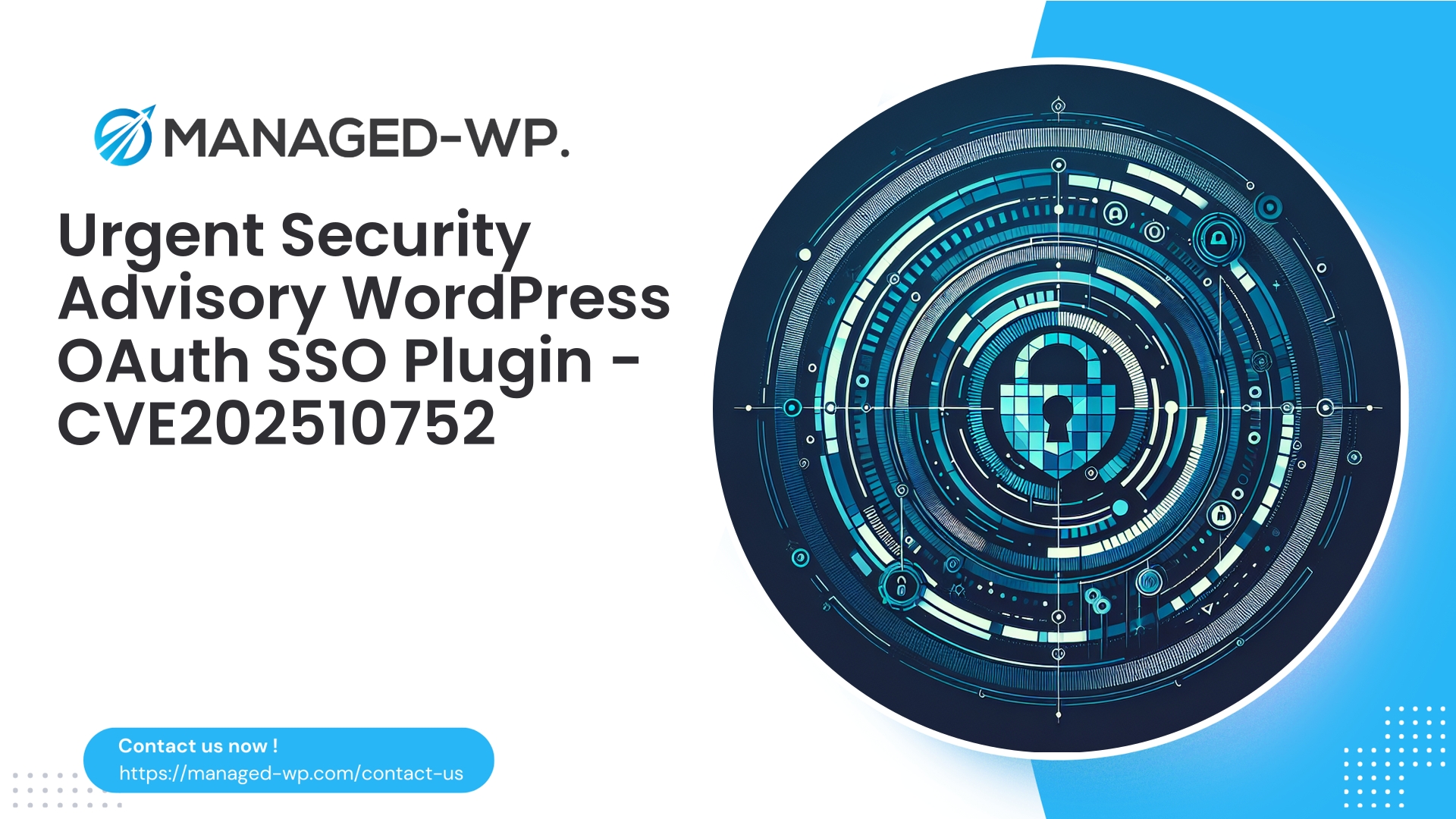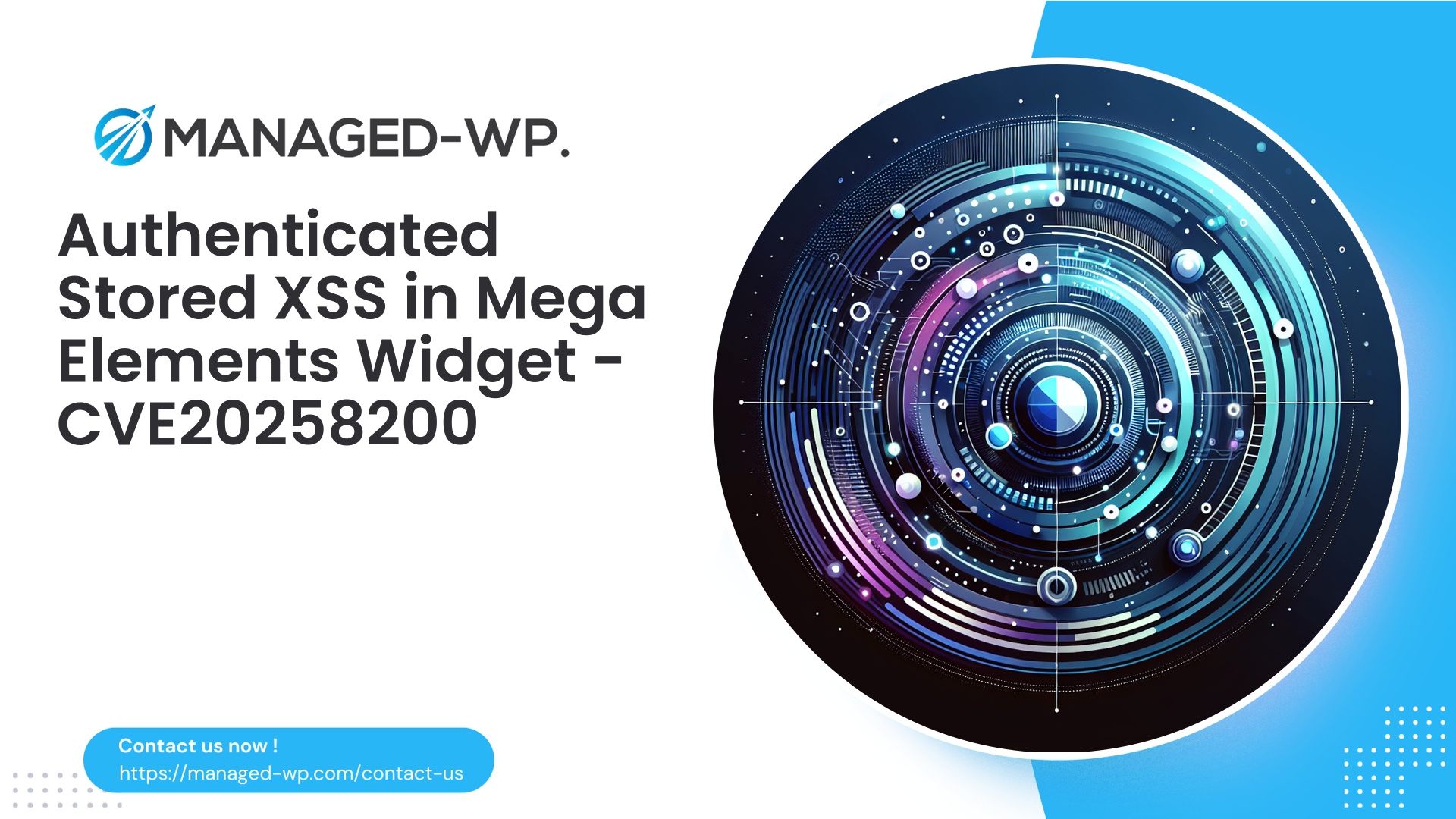| 插件名称 | OAuth 单点登录 – SSO(OAuth 客户端) |
|---|---|
| 漏洞类型 | CSRF |
| CVE编号 | CVE-2025-10752 |
| 紧急 | 低的 |
| CVE 发布日期 | 2025-09-25 |
| 源网址 | CVE-2025-10752 |
紧急安全公告:了解 OAuth 单点登录 (SSO) (OAuth 客户端) CSRF 漏洞 (CVE-2025-10752) 及您的紧急应对计划
发布日期: 2025年9月25日
严重程度: 低(CVSS 4.3)
受影响的版本: ≤ 6.26.12
修复程序已发布: 6.26.13
CVE标识符: CVE-2025-10752
作为美国领先的 WordPress 安全专家,Managed-WP 特此提醒所有 WordPress 管理员和安全团队注意一个影响 OAuth 单点登录 (SSO) 插件的严重跨站请求伪造 (CSRF) 漏洞。该漏洞使恶意攻击者能够诱使已认证的管理员触发未经授权的插件操作,从而导致未经授权的配置更改。
这份全面的简报详细分析了漏洞、潜在的利用场景、检测方法以及可操作的补救措施,旨在立即保护您的 WordPress 环境。
执行摘要
- OAuth 单点登录 – SSO(OAuth 客户端)插件版本最高为 6.26.12 存在 CSRF 漏洞(CVE-2025-10752)。
- 攻击者可以利用这一点,诱骗已登录的管理员访问恶意页面,从而导致未经授权的插件配置更改。
- 将插件更新到 6.26.13 或更高版本对于弥补此安全漏洞至关重要。
- 如果不能立即进行修补,强烈建议应用 Web 应用程序防火墙 (WAF) 规则或虚拟补丁作为临时安全措施。
- Managed-WP 客户可享受完全托管的 WAF 保护,包括虚拟修补以阻止已知漏洞,而无需人工干预。
技术概述:发生了什么?
跨站请求伪造 (CSRF) 是一种众所周知的网络漏洞,攻击者可以利用受信任的用户会话在未经用户同意的情况下执行未经授权的操作。WordPress 通常通过验证随机数 (nonce) 和验证请求来源来防御 CSRF 攻击。
在这个 OAuth 单点登录插件漏洞中,关键的插件操作(例如修改 OAuth 设置)没有实现正确的 nonce 或来源检查。因此,已认证的管理员访问恶意网站时,可能会在不知情的情况下触发修改插件设置的请求,从而利用其当前会话凭据。
关键技术细节:
- 需要诱骗具有管理员权限的已认证用户访问恶意资源。
- 该漏洞的 CVSS 评分较低 (4.3),这与需要用户交互和管理权限相符。
- 插件版本 6.26.13 中引入了最终修复程序 - 请立即更新。
你必须假设的攻击场景
-
劫持插件设置:
攻击者可以提交精心构造的表单或请求,更改重要的 OAuth 参数(如重定向 URI 或客户端密钥),从而影响身份验证流程。 -
账户关联滥用:
操纵 OAuth 回调以链接攻击者控制的身份或破坏会话逻辑,可能会破坏用户信任。 -
权限提升:
利用二级插件交互创建或修改用户角色,可能授予未经授权的访问权限。 -
后门植入:
改变插件行为以启用不安全的日志记录或攻击者控制的端点,从而实现长期持久性。
在实践中,攻击者会运用社会工程策略——网络钓鱼、恶意工单或嵌入式内容——来诱使管理员进行交互,这使得这些攻击途径变得现实且紧迫。
如何验证您网站上的漏洞
-
检查已安装的插件版本:
- 进入 WordPress 管理后台 → 插件,找到“OAuth 单点登录 – SSO(OAuth 客户端)”。
- 如果您的版本低于或等于 6.26.12,则您的网站存在漏洞。6.26.13 及更高版本已修复此漏洞。
-
识别风险暴露:
- 检查您的网站是否公开了 REST 端点,或者与插件相关的 admin-post/admin-ajax 操作是否会更改设置。
- 检查是否存在未经身份验证的可访问 POST 端点,这些端点会执行状态更改操作。
-
分析日志以发现可疑活动:
- 扫描访问日志和错误日志,查找对插件特定 URL 的异常 POST 请求。
- 查找与插件相关操作相关的异常引荐来源、用户代理和 IP 地址。
-
检查管理员活动:
- 将用户登录和管理操作与可疑的外部请求或更改进行关联。
立即补救清单
-
立即更新插件:
通过标准的 WordPress 更新程序部署 OAuth 单点登录 – SSO(OAuth 客户端)6.26.13 或更高版本。
如条件允许,在正式上线前先在测试环境中进行测试。 -
如果出现更新延迟,则部署 WAF/虚拟补丁:
Managed-WP 客户端可以启用针对此漏洞定制的自动虚拟补丁规则。
对于手动设置,请使用提供的示例 WAF 规则(见下文)。 -
强制重新验证和轮换凭证:
使所有管理员会话过期,并要求重新输入密码。
在插件内轮换客户端密钥和 OAuth 令牌。 -
审核未经授权的更改:
检查 OAuth 重定向 URI 和客户端配置。
验证用户角色和新创建的管理员帐户。
检查文件系统是否存在可疑修改。 -
加强监控和日志记录:
实现管理配置变更的实时警报。
启用 POST/GET 请求负载的详细日志记录,以便进行审计。 -
向利益相关者传达风险:
告知所有管理员用户在登录后避免访问可疑链接或网站。
记录所有缓解措施和调查结果,以便进行问责和审计追踪。
入侵指标 (IoC) 和检测策略
- 插件设置中的 OAuth 重定向 URL 或凭据发生意外更改。
- 创建未经授权的管理员或高级帐户。
- 服务器日志中记录了指向插件端点的带有外部引用的 POST 请求。
- 可疑的管理员活动与外部流量模式之间的相关性。
- 存在不规则或未经授权的 WP Cron 作业。
待审查的日志来源:
- Web 服务器访问/错误日志(Apache、Nginx)。
- WordPress审计日志(如果已实现)。
- PHP错误和调试日志。
- 主机控制面板文件变更日志。
用于临时保护的 WAF 和虚拟补丁规则示例
以下是旨在阻止针对此插件的 CSRF 攻击的概念性 ModSecurity 风格规则。请在部署到生产环境之前进行全面配置和测试。
-
对发送到管理端点的 POST 请求强制执行有效的 Referer 标头:
# 拒绝 OAuth 插件相关管理页面上缺少有效内部引用页的 POST 请求。安全规则 REQUEST_METHOD "@streq POST" "chain,phase:2,deny,id:200001,log,msg:'阻止 OAuth 插件缺少有效引用页的 POST 请求'" 安全规则 REQUEST_URI "@rx (wp-admin/admin-post.php|wp-admin/admin-ajax.php|wp-json/.+oauth.+|wp-content/plugins/.+oauth.+)" 安全规则 &REQUEST_HEADERS:Referer "@gt 0" "chain" 安全规则 REQUEST_HEADERS:Referer "!@rx ^https?://(yourdomain\.com|www\.yourdomain\.com)/"注意:某些合法客户端会移除 Referer 标头;请在您的环境中进行评估。
-
插件操作中需要随机数令牌:
# 阻止缺少 OAuth 插件操作 _wpnonce 参数的请求 SecRule REQUEST_URI "@rx /wp-admin/admin-post.php.*(action=oauth|action=sso|plugin_action)" "phase:2,chain,deny,id:200002,log,msg:'OAuth 插件操作缺少 nonce'" SecRule REQUEST_ARGS "!@contains _wpnonce" -
速率限制可疑配置更改:
- 限制每个 IP 地址向插件端点发送多个快速 POST 请求的次数。
- 实施阻止阈值以遏制自动化攻击。
-
过滤可疑的 Content-Type 标头:
- 阻止与漏洞利用载荷关联的格式错误或意外内容类型。
-
已知漏洞利用模式的特征块:
- 针对已知的恶意参数组合,创建并部署定向拦截机制。
Managed-WP 为客户无缝集成这些保护措施,消除人工操作负担,并同时保护多个房产。
通过安全示例理解 CSRF
以下是一个经过脱敏处理的示例,用于说明 CSRF 的概念,帮助安全团队理解 nonce 验证的重要性。这只是一个教学示例,并非实际的漏洞利用程序。
<!-- Educational CSRF demonstration -->
<html>
<body>
<form id="csrfForm" method="POST" action="https://targetsite.example/wp-admin/admin-post.php?action=update_oauth_settings">
<input type="hidden" name="client_id" value="malicious-client-id">
<input type="hidden" name="redirect_uri" value="https://attacker.example/callback">
</form>
<script>
// Submits form on behalf of logged-in admin via their authenticated session
document.getElementById('csrfForm').submit();
</script>
</body>
</html>
此示例演示了攻击者控制的页面如何利用经过身份验证的管理员会话提交未经授权的请求,从而绕过 nonce 验证的缺失。
事件后调查与恢复
如果您怀疑存在剥削行为:
- 立即保存所有相关日志和审计跟踪记录。
- 检查插件设置:重定向 URI、客户端密钥和已启用的 OAuth 提供程序。
- 检查 WordPress 用户是否存在未经授权的管理员/编辑添加或可疑的角色变更。
- 扫描文件系统,检查是否存在未经授权的修改,特别是 wp-content 和 plugin 目录。
- 使所有管理员会话失效;强制重新验证身份。
- 轮换 OAuth 密钥和 API 密钥。
- 检查是否存在出站网络异常和未经授权的计划任务。
检测到恶意代码、shell 或持久后门需要立即采取高级事件响应措施,可能还需要专业的取证服务。
长期安全最佳实践
- 应用最小权限原则:限制管理员账户并分离职责。
- 缩小攻击面:卸载未使用或不必要的插件。
- 对特权用户严格执行多因素身份验证(MFA)。
- 及时更新 WordPress 核心程序、主题和插件。
- 使用全面的活动监控功能,对敏感变化进行实时警报。
- 在生产环境部署之前,采用测试环境来测试插件更新。
- 部署托管式 WAF 解决方案,以缓解新出现的威胁并强制执行虚拟补丁。
Managed-WP 如何保护您的 WordPress 环境
Managed-WP 采用积极主动、专家主导的方式,为美国市场量身定制 WordPress 安全解决方案。我们的服务包括:
- 托管 WAF 规则集: 持续更新,以精准应对新出现的漏洞,并将误报率降至最低。
- 虚拟修补: 通过规则部署实现即时保护,在更新插件的同时消除操作负担。
- 持续恶意软件扫描: 检测可疑文件、意外修改和入侵迹象。
- 优化性能: 企业级防护,网站延迟极低。
我们的托管服务使代理商、开发人员和网站所有者能够降低安全开销,同时保持多个 WordPress 网站的安全和合规性。
隆重推出托管型 WP 免费安全层——您的第一道防线
隆重推出: 即时、实用的保护,零成本、零摩擦。
我们的免费套餐提供基本的托管防火墙服务,包括 WAF、恶意软件扫描和针对 OWASP Top 10 网络威胁的缓解措施,且带宽不限。这项基础服务能够帮助每位 WordPress 开发人员和网站所有者立即提升安全防护能力,同时为全面升级做好准备。
对于高级用户和多站点运营商,我们的标准版和专业版计划提供增强的自动恶意软件清除、精细的访问控制、安全报告和实时虚拟补丁。
安全团队推荐响应时间表
- 30分钟内:
- 审核您环境中所有插件的版本状态。
- 如果网站被阻止,请立即更新存在漏洞的网站或应用WAF保护措施。
- 2小时内:
- 强制执行管理员注销和重新认证协议。
- 根据需要轮换 OAuth 和插件相关的凭据。
- 24小时内:
- 完成所有补丁部署。
进行安全扫描和配置审核。 - 实施或改进对 OAuth 相关变更的监控。
- 完成所有补丁部署。
- 进行中:
- 至少保留90天的日志。
- 每月对用户权限和活动进行审核。
Managed-WP 安全团队闭幕致辞
CVE-2025-10752 凸显了缺乏严格验证的 WordPress 插件面临的 CSRF 攻击的持续风险。虽然该漏洞由于依赖用户交互而获得了较低的 CVSS 评分,但考虑到其可能导致未经授权的管理修改,其影响不容低估。
最佳防御措施仍然是及时修补插件、限制管理员帐户暴露,并利用托管 WAF 技术进行主动虚拟修补。
如果您的团队在规则部署、事件响应清单或优先级修复计划方面需要帮助,Managed-WP随时准备提供支持。我们的免费方案可立即提供基线加固,无需任何费用,从而在您进行补丁更新的同时,快速提升安全性。
保持警惕,如需针对 WordPress 环境量身定制的专家安全支持,请联系 Managed-WP 安全团队。
— Managed-WP 安全团队
关键资源与参考资料
- CVE-2025-10752 详情
- OAuth 单点登录 – SSO(OAuth 客户端)官方插件 6.26.13 版本更新日志
- WordPress开发者手册:安全随机数和CSRF保护
- 分析服务器日志、审计跟踪和文件完整性扫描的标准流程
通过您的控制面板联系 Managed-WP 支持,获取可导出的检查清单或定制的 WAF 规则包,以加快部署速度。



















